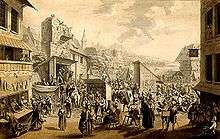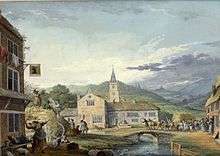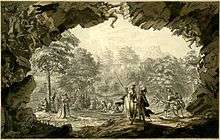Samuel Hieronymus Grimm
Samuel Hieronymus Grimm (January 18, 1733 – April 14, 1794)[1] was an 18th-century Swiss landscape artist who worked in oils (until 1764), watercolours, and pen and ink media.
Grimm specialised in documenting historical scenes and events; he also illustrated books such as Gilbert White's The Natural History and Antiquities of Selborne.
Life and work

Grimm was born in Burgdorf, in Switzerland, and studied under Johann Ludwig Aberli[2] in Bern. He then travelled in France until 1768 before moving to England. There he produced etchings, pen and ink drawings, and watercolours, but before his arrival he had already supplied the illustrations for Friedrich von Hagedorn's "Poetische Werke" which was published between 1769 and 1772.[2]
Critics of his time remarked that Grimm was a "man of genius".[3] He was adopted as a travelling companion of the Rev. Sir Richard Kaye who became Rector of Kirkby in Ashfield in 1765 - his role was to record "anything curious".[4] In 1775 Grimm was known to be in Derbyshire and Staffordshire, and by 1778 was working in London.[3]
Grimm died in Tavistock Street in London on 14 April 1794, and left his money to a niece in Switzerland. He was buried at St Paul's church in Covent Garden in a service taken by Kaye, who had become the Dean of Lincoln.[1]
Role as a recording historian


Grimm's speciality was visually documenting historical relics in the kind of detail that might otherwise have gone unreported. For example, the British Library credits him with documenting the only surviving scene of the coronation of Edward VI.[5] Another example of a unique artistic recording is the 1790 ink-wash drawing he produced of the chapel at Calcot Manor in Gloucestershire, long since ruined, and a drawing of Samuel Pegge's church which was later rebuilt after a fire. He also made a number of drawings of the body of Little Saint Hugh of Lincoln when his coffin was opened.
The British Library possesses 2,662 drawings in twelve volumes by this artist, covering many of the counties of England[6] and a further 886 watercolours, in seven volumes, dedicated to the county of Sussex.[6]
Patronage
Grimm's leading patron was Sir Richard Kaye, but this was not his only income. He also undertook work for the naturalist Gilbert White, illustrating his The Natural History and Antiquities of Selborne,[6] and Sir William Burrell. Burrell gave Grimm's Sussex collection in 1796, whilst Sir Richard bequeathed his collection of Grimm's art to the British Museum in 1810. Luckily they valued his work more than Grimm himself, who had left instructions for his papers to be destroyed after his death.[6]
References
- 1 2 The Gentleman's Magazine, 1794, p399
- 1 2 Samuel Grimm at Answers.com accessed 21 September 2007
- 1 2 Henry Watson Kent. Bibliographical Notes on One Hundred Books Famous in English Literature (New York, The Grolier Club, 1903).
- ↑ Topographical drawings (British Library).
- ↑ Peter Clark, D. M. Palliser, Martin Daunton. The Cambridge Urban History of Britain (Cambridge University Press, 2000). ISBN 0-521-43141-7
- 1 2 3 4 ‘Everything Curious’:Samuel Hieronymus Grimm and Sir Richard Kaye by Brett Dolman. Accessed September 2007
Exhibition
- Kunstmuseum Bern (17.01. – 21.04.2014) Samuel Hieronymus Grimm (1733-1794). A Very English Swiss,
A Talented and much-admired Swiss in England.
Further reading
| Wikimedia Commons has media related to Samuel Hieronymus Grimm. |
- Clay, Rotha Mary. Samuel Hieronymus Grimm of Burgdorf in Switzerland (Faber, 1941).
- Dolman, Brett. 'Everything Curious':Samuel Hieronymus Grimm and Sir Richard Kaye.
- Plaideux, Hugues. « Samuel Hieronymus Grimm (1733-1794) : ses oeuvres en Normandie et l'iconographie authentique de l'abbaye de Cherbourg », in Les Anglais en Normandie, Actes du 45e Congrès des Sociétés historiques et archéologiques de Normandie (Saint-Sauveur-le-Vicomte, octobre 2010), vol. 16, 2011, p. 373-384.
External links
- S H Grimm online (ArtCyclopedia)
- "Grimm, Samuel Hieronymus". SIKART dictionary and database.
- South-east view of St Lawrence Church, Whitwell, Derbyshire (Christie's)